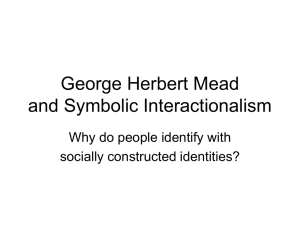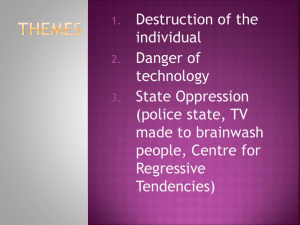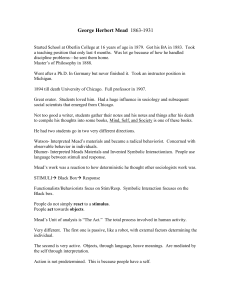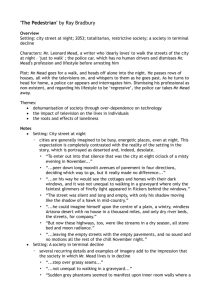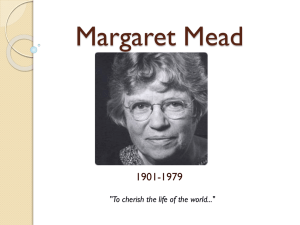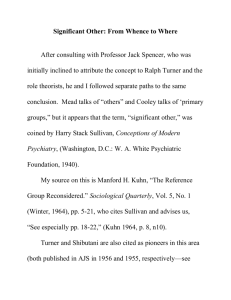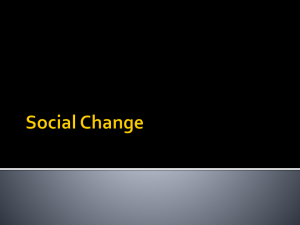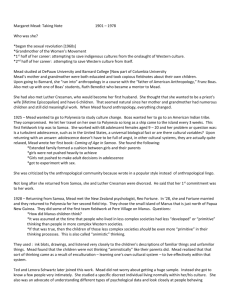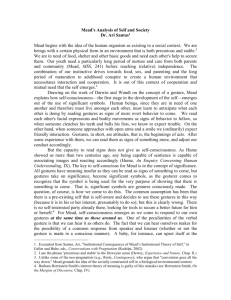SYMBOLIC INTERACTION
advertisement
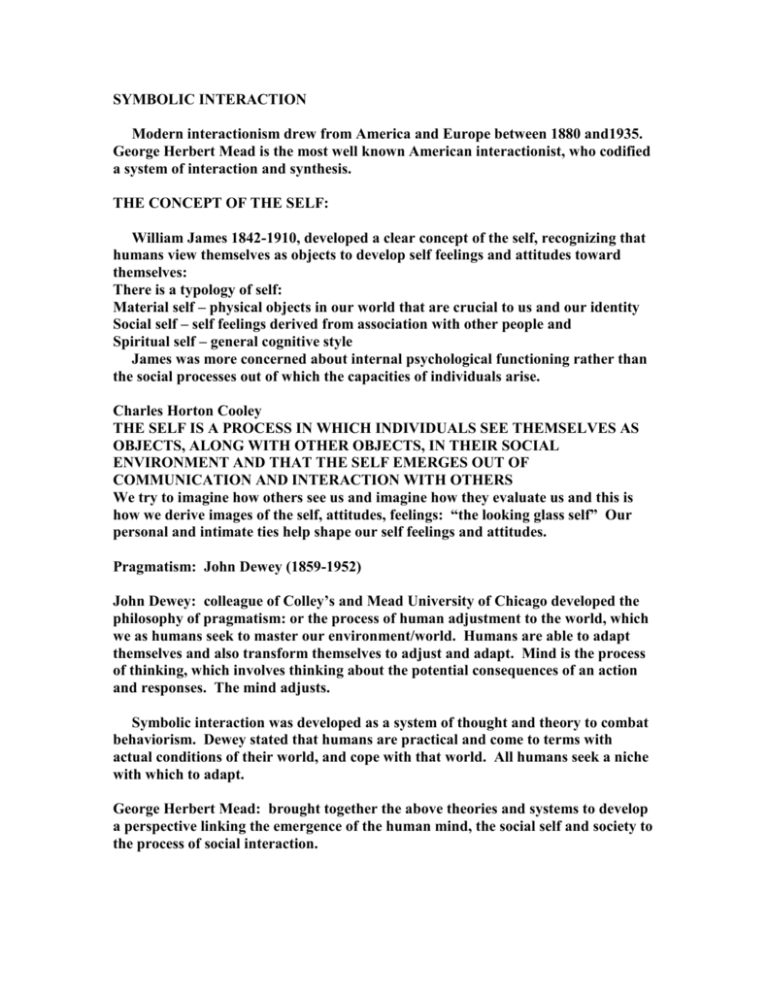
SYMBOLIC INTERACTION Modern interactionism drew from America and Europe between 1880 and1935. George Herbert Mead is the most well known American interactionist, who codified a system of interaction and synthesis. THE CONCEPT OF THE SELF: William James 1842-1910, developed a clear concept of the self, recognizing that humans view themselves as objects to develop self feelings and attitudes toward themselves: There is a typology of self: Material self – physical objects in our world that are crucial to us and our identity Social self – self feelings derived from association with other people and Spiritual self – general cognitive style James was more concerned about internal psychological functioning rather than the social processes out of which the capacities of individuals arise. Charles Horton Cooley THE SELF IS A PROCESS IN WHICH INDIVIDUALS SEE THEMSELVES AS OBJECTS, ALONG WITH OTHER OBJECTS, IN THEIR SOCIAL ENVIRONMENT AND THAT THE SELF EMERGES OUT OF COMMUNICATION AND INTERACTION WITH OTHERS We try to imagine how others see us and imagine how they evaluate us and this is how we derive images of the self, attitudes, feelings: “the looking glass self” Our personal and intimate ties help shape our self feelings and attitudes. Pragmatism: John Dewey (1859-1952) John Dewey: colleague of Colley’s and Mead University of Chicago developed the philosophy of pragmatism: or the process of human adjustment to the world, which we as humans seek to master our environment/world. Humans are able to adapt themselves and also transform themselves to adjust and adapt. Mind is the process of thinking, which involves thinking about the potential consequences of an action and responses. The mind adjusts. Symbolic interaction was developed as a system of thought and theory to combat behaviorism. Dewey stated that humans are practical and come to terms with actual conditions of their world, and cope with that world. All humans seek a niche with which to adapt. George Herbert Mead: brought together the above theories and systems to develop a perspective linking the emergence of the human mind, the social self and society to the process of social interaction. SYMBOLIC INTERACTION PAGE 2 Human organisms must learn to cooperate with each other in group contexts in order to survive, this survival and adjustment is retained within human society. The MIND according to Mead Uses symbols to designate objects Seeks alternatives in actions Inhibits inappropriate actions and selects proper courses of action (imaginative rehearsal) The mind is a process, not a structure Humans through processes develop gestures of communication with common meanings, and assist in communication of desires and wanted and courses of action We perceive and interpret gestures with other humans with whom we must cooperate for survival We are also able to put ourselves in another’s place and “take the role of the other” The SELF according to Mead Humans can represent themselves as an object as a basis for self assessment and evaluation We derive an image of ourselves as an object, and this is how we develop our self concept We role take and via role taking we can assume perspectives of others, the first stage is play, second is game where we engage in organized activity, learn cooperation, and rules, finally “take the role of the generalized other or community of attitudes” SOCIETY according to Mead Society and institutions represent the organized and patterned interactions among diverse individuals, this comes from the capacity of our mind where we can take roles of others and rehearse alternative lines of activity while coordinating their activities. Society is dependent upon the capacities of the self, via evaluating oneself. Society and its institutions are maintained, yet society is constantly in flux and filled with changes. Mead did not approve of rigid and oppressive patterns of social organization, he viewed society as a constructed phenomenon that arises out of the adjustive interactions among individuals. Society can be altered or reconstructed…..Mead also realized that change is frequently unpredictable. He developed, from William James the concepts of the I and me: The I is the part of the self that is impulsive, spontaneous, not always predicated SYMBOLIC INTERACTION Page 3 The me is accumulated experiences which are only known by me and actually transpired and the consequences that are “known” via this experience Mead’s synthesis conceptually become role theory……….the idea of “playing a role, and roles are linked to structural positions in society, we are confined to playing roles within the confines of the positions of social structure….and people play multiple roles in society…… “Thinking is an active process as one develops a formative consciousness” Herbert Blumer and Manford Kuhn Herbert Blumer, studied under Mead, took over at Un. Of Chicago after Mead died. Blumer and Kuhn agree on the following: Symbolic interaction is a distinctive theoretical perspective Humans create and use symbols Symbols help us communicate via voice, language, and body language People can communicate, interact, and read each other via taking the role of the other and by anticipating the responses of others Mind, self, society are intimately connected to one another Humans “define the situation (WI Thomas) via naming categorizing and orienting themselves to objects including seeing themselves as objects, and the ability to derive a self image Disagreements: BLUMER: Blumer emphasized that humans can view themselves as objects and insert any object into an interaction situation – humans are active in the creation of their own world to which they respond. They can only understand via their experience and their interpretation of social organization and there is always room for spontaneity in every situation. KUHN: Kuhn emphasized that each person has a core self, every human has a stable set of meanings and attitudes towards themselves through socialization. This core self shapes and constrains the way we define situations. Humans seek and have continuity and predictability. K Edwards 8/12/04
